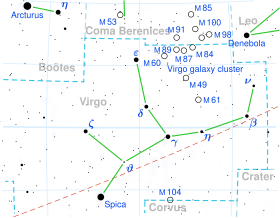Nu Virginis
| Observation data Epoch J2000.0 Equinox J2000.0 | |
|---|---|
| Constellation | Virgo |
| Right ascension | 11h 45m 51.55957s[1] |
| Declination | +06° 31′ 45.7413″[1] |
| Apparent magnitude (V) | 4.04[2] |
| Characteristics | |
| Evolutionary stage | asymptotic giant branch[3] |
| Spectral type | M1 III[4] |
| U−B color index | +1.80[2] |
| B−V color index | +1.52[2] |
| Astrometry | |
| Radial velocity (Rv) | 50.19±0.30[5] km/s |
| Proper motion (μ) | RA: −18.96[1] mas/yr Dec.: −181.56[1] mas/yr |
| Parallax (π) | 11.10 ± 0.18 mas[1] |
| Distance | 294 ± 5 ly (90 ± 1 pc) |
| Absolute magnitude (MV) | −0.87[6] |
| Details | |
| Mass | 1.6[7] M☉ |
| Radius | 54[5] R☉ |
| Luminosity | 631[5] L☉ |
| Surface gravity (log g) | 1.0[5] cgs |
| Temperature | 4,009[5] K |
| Metallicity [Fe/H] | 0.06[5] dex |
| Rotational velocity (v sin i) | 3.8[5] km/s |
| Other designations | |
| Database references | |
| SIMBAD | data |
Nu Virginis (ν Vir, ν Virginis) is a star in the zodiac constellation of Virgo. It has an apparent visual magnitude of 4.04[2] and can be seen with the naked eye. Because the star lies near the ecliptic it is subject to occultations by the Moon.[9] Parallax measurements provide an estimated distance of around 294 light years from the Sun.
Nu Virginis is an M-type red giant, currently on the asymptotic giant branch,[3] with a stellar classification of M1 III.[4] It is an SRB-type[10] semiregular variable star with its brightness varying by 0.0125 in magnitude.[11] These variations have four periods lasting 11.1, 12.3, 16.8, and 23.7 days.[12] This star has about 1.6 times the mass of the sun, but it has expanded to 54 times the Sun's radius and shines 631 times as brightly as the Sun. The effective temperature of its outer atmosphere is 4,009 K.[7]
References
- ^ a b c d e van Leeuwen, F. (2007), "Validation of the new Hipparcos reduction", Astronomy and Astrophysics, 474 (2): 653–664, arXiv:0708.1752, Bibcode:2007A&A...474..653V, doi:10.1051/0004-6361:20078357.
- ^ a b c d Mermilliod, J.-C. (1986), "Compilation of Eggen's UBV data, transformed to UBV (unpublished)", Catalogue of Eggen's UBV data, SIMBAD, Bibcode:1986EgUBV........0M.
- ^ a b Eggen, Olin J. (July 1992), "Asymptotic giant branch stars near the sun", Astronomical Journal, 104 (1): 275–313, Bibcode:1992AJ....104..275E, doi:10.1086/116239.
- ^ a b Morgan, W. W.; Keenan, P. C. (1973), "Spectral Classification", Annual Review of Astronomy and Astrophysics, 11: 29–50, Bibcode:1973ARA&A..11...29M, doi:10.1146/annurev.aa.11.090173.000333.
- ^ a b c d e f g Massarotti, Alessandro; et al. (January 2008), "Rotational and radial velocities for a sample of 761 HIPPARCOS giants and the role of binarity", The Astronomical Journal, 135 (1): 209–231, Bibcode:2008AJ....135..209M, doi:10.1088/0004-6256/135/1/209.
- ^ Pace, G.; et al. (April 2003), "The Wilson-Bappu effect: A tool to determine stellar distances", Astronomy and Astrophysics, 401: 997–1007, arXiv:astro-ph/0301637, Bibcode:2003A&A...401..997P, doi:10.1051/0004-6361:20030163.
- ^ a b Tsuji, Takashi (May 2007). "Isotopic abundances of Carbon and Oxygen in Oxygen-rich giant stars". In Kupka, F.; Roxburgh, I.; Chan, K. (eds.). Convection in Astrophysics, Proceedings of IAU Symposium #239 held 21-25 August, 2006 in Prague, Czech Republic. Proceedings of the International Astronomical Union. Vol. 2. pp. 307–310. arXiv:astro-ph/0610180. Bibcode:2007IAUS..239..307T. doi:10.1017/S1743921307000622.
{{cite conference}}: CS1 maint: postscript (link) - ^ "* nu. Vir". SIMBAD. Centre de données astronomiques de Strasbourg. Retrieved 2016-09-08.
{{cite web}}: CS1 maint: postscript (link) - ^ White, Nathaniel M.; Feierman, Barry H. (September 1987), "A Catalog of Stellar Angular Diameters Measured by Lunar Occultation", Astronomical Journal, 94: 751, Bibcode:1987AJ.....94..751W, doi:10.1086/114513.
- ^ Kazarovets, E. V.; et al. (1999), "The 74th Special Name-list of Variable Stars", Information Bulletin on Variable Stars (4659), Bibcode:1999IBVS.4659....1K.
- ^ Koen, Chris; Eyer, Laurent (March 2002). "New periodic variables from the Hipparcos epoch photometry". Monthly Notices of the Royal Astronomical Society. 331 (1): 45–59. arXiv:astro-ph/0112194. Bibcode:2002MNRAS.331...45K. doi:10.1046/j.1365-8711.2002.05150.x.
{{cite journal}}: CS1 maint: postscript (link) CS1 maint: unflagged free DOI (link) - ^ Tabur, V.; et al. (December 2009), "Long-term photometry and periods for 261 nearby pulsating M giants", Monthly Notices of the Royal Astronomical Society, 400 (4): 1945–1961, arXiv:0908.3228, Bibcode:2009MNRAS.400.1945T, doi:10.1111/j.1365-2966.2009.15588.x.
{{citation}}: CS1 maint: unflagged free DOI (link)

